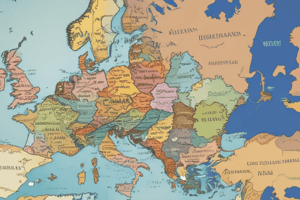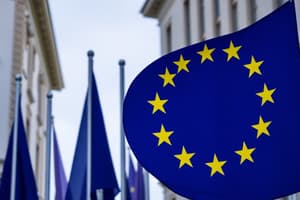Podcast
Questions and Answers
What was the primary objective of European politicians in 1945 after World War II?
What was the primary objective of European politicians in 1945 after World War II?
- To establish a military alliance
- To ensure economic cooperation among states (correct)
- To create a unified currency
- To promote cultural exchanges
Which treaty established the foundations for a common foreign and security policy in the European Union?
Which treaty established the foundations for a common foreign and security policy in the European Union?
- ECSC Treaty
- Treaty of Rome
- Treaty of Versailles
- Maastricht Treaty (correct)
Which countries were part of the initial formation of the European Economic Community (EEC)?
Which countries were part of the initial formation of the European Economic Community (EEC)?
- Poland, Hungary, Czech Republic, Slovakia
- Germany, France, Italy, Belgium, Netherlands, Luxembourg (correct)
- Ireland, Greece, Portugal, Spain
- Austria, Sweden, Finland, Norway
In which year did the United Kingdom vote to leave the European Union?
In which year did the United Kingdom vote to leave the European Union?
What significant event occurred in 2004 concerning the European Union?
What significant event occurred in 2004 concerning the European Union?
Which countries joined the EU in 1995?
Which countries joined the EU in 1995?
What has significantly halted the accession process for Turkey into the EU?
What has significantly halted the accession process for Turkey into the EU?
What are the main challenges currently facing the European Union?
What are the main challenges currently facing the European Union?
Which countries joined the EU in the southern expansion of the 1980s?
Which countries joined the EU in the southern expansion of the 1980s?
What was the original name of the organization established by the founding states before it became the EU?
What was the original name of the organization established by the founding states before it became the EU?
Flashcards
ECSC (European Coal and Steel Community)
ECSC (European Coal and Steel Community)
The European Coal and Steel Community (ECSC) was established in 1951 to bring Germany and France together economically, preventing future conflicts. It involved placing coal and steel production under common authority.
Treaty of Rome
Treaty of Rome
The Treaty of Rome, signed in 1957, established the European Economic Community (EEC), uniting six founding members (Germany, France, Italy, Belgium, the Netherlands, and Luxembourg). This marked the beginning of closer economic integration.
European Communities (EC)
European Communities (EC)
The European Communities (EC) emerged from the combination of the ECSC, EEC, and Euratom. This consolidated economic cooperation and paved the way for the EU.
Maastricht Treaty
Maastricht Treaty
Signup and view all the flashcards
Eastern Enlargement
Eastern Enlargement
Signup and view all the flashcards
Northern Expansion
Northern Expansion
Signup and view all the flashcards
Southern Expansion
Southern Expansion
Signup and view all the flashcards
Accession Process
Accession Process
Signup and view all the flashcards
Brexit
Brexit
Signup and view all the flashcards
Candidate Countries
Candidate Countries
Signup and view all the flashcards
Study Notes
The Formation and Expansion of the European Community
-
The primary goal of European policymakers after World War II was to prevent another war.
-
This led to the creation of the European Coal and Steel Community (ECSC) in 1951 which united the coal and steel industries of member countries. This initially involved Germany, France, Italy, Belgium, the Netherlands, and Luxembourg.
-
The six countries signed the Treaty of Rome in 1957, forming the European Economic Community (EEC), pooling economic resources.
-
The EEC aimed to remove trade barriers and promote economic integration within the community.
-
Subsequent enlargement steps occurred. The "Nordic enlargement" included Denmark, Ireland, and the UK in 1973.
-
The "Southern enlargement" saw Greece join in 1981, followed by Spain and Portugal in 1986..
-
The Maastricht Treaty, signed in 1991, transformed the EEC into the European Union (EU).
-
The EU now encompasses economic, political, and legal union along with a common currency, and further expansions through various treaties.
Enlargement of the European Union
- In 1995, Austria, Finland, and Sweden joined the EU.
- The enlargement to the East ("Eastern Enlargement") occurred in 2004 with the addition of 10 new countries.
- Bulgaria and Romania joined in 2007, and Croatia became a member in 2013.
- Significant events of the 21st Century have challenged the EU, including the UK's departure (Brexit) in 2020.
Candidate Countries and Future Expansion
- Several countries are seeking membership in the EU.
- The process to become a member involves several steps and often involves political changes and reforms within candidate countries.
- The addition of new countries to the EU is a complex process with economic and political implications, and challenges for the already established member countries.
Studying That Suits You
Use AI to generate personalized quizzes and flashcards to suit your learning preferences.
Description
Explore the history of the European Community from its origins post-World War II to its transformation into the European Union. Learn about key treaties, member expansions, and the goals behind economic integration. This quiz covers significant milestones in European cooperation and unity.




